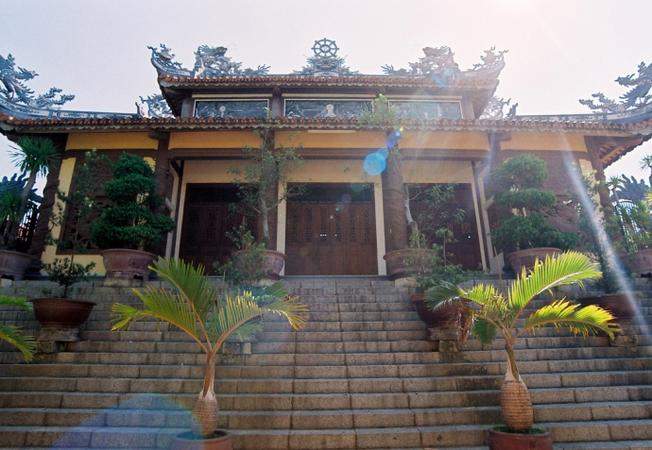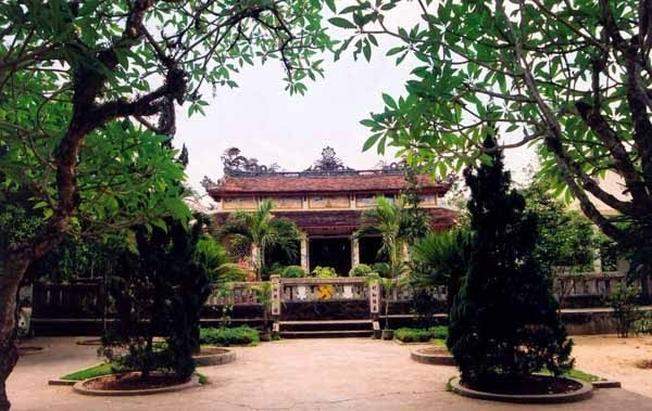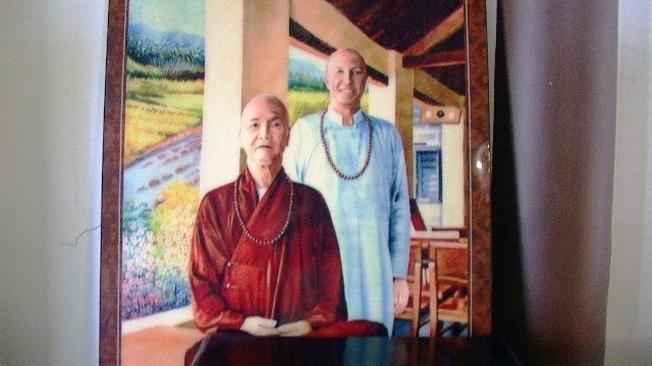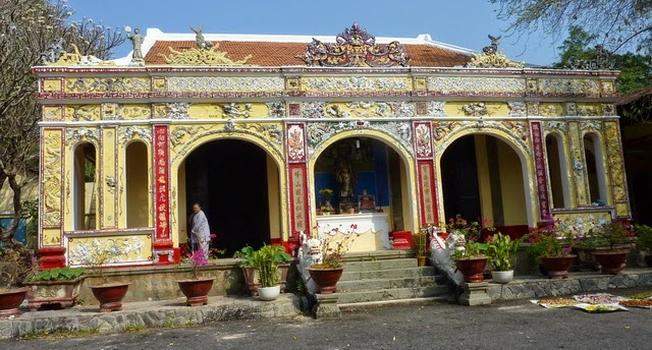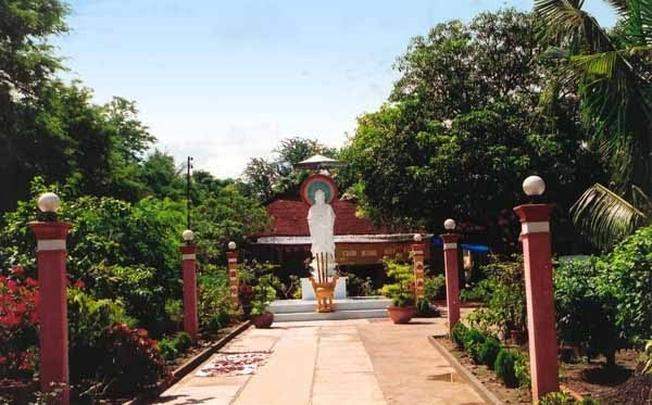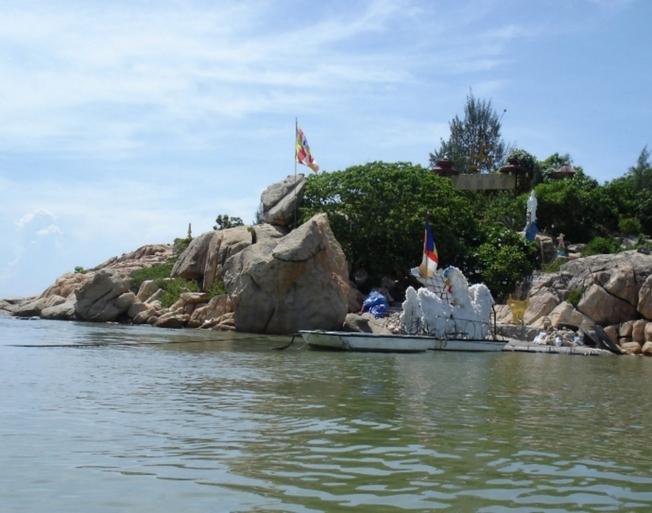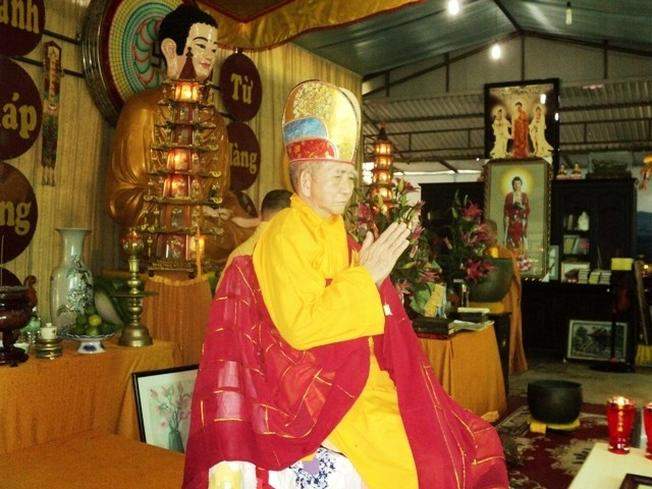During the trip to Nha Trang, tourists often come to the famous pagodas, which are places to visit Nha Trang. The city has four beautiful, sacred temples frequented by locals and tourists who enjoy vegetarian dishes.
Hai Duc Pagoda
Introduction to Hai Duc Pagoda Nha Trang: A Spiritual Oasis
Hai Duc Pagoda in Nha Trang stands as a renowned spiritual destination in Khanh Hoa province, where travelers find themselves enchanted by its distinctive architecture and breathtaking natural surroundings.
Situated at 51 Hai Duc Street, Phuong Son Ward, west of Nha Trang City, Khanh Hoa province, the pagoda’s uphill location requires visitors to ascend a stone-studded slope, offering a picturesque ascent surrounded by lush greenery. According to local lore, in 1883, the pagoda, initially named Chua Hoi (Duyen Sanh Tu), was a modest meditation place under the guidance of Vien Giac Zen Master. In 1891, it underwent expansion and transformation into a grand monastery. It was during this period that the pagoda assumed the name Hai Duc Tu or Hai Duc Pagoda, as known today.
In 1938, realizing the growing crowds and loss of tranquility, head monk Bich Khong Dai Su left Hai Duc Pagoda for Thuy Monastery. By early 1943 (Year of the Rooster), the reconstruction of Hai Duc Pagoda commenced and was completed in 1945, maintaining its architectural integrity.
|
|
|---|
| Famous Hai Duc Pagoda (Collected photos) |
Unique Architectural Splendor of Hai Duc Pagoda
Hai Duc Pagoda’s architectural allure is another compelling reason for multiple visits. The pagoda boasts an Oriental architectural style, exuding an ancient and captivating charm—every intricate detail, whether dragons or phoenixes, exhibits meticulous craftsmanship and vividness. The design’s use of deep blue and red hues imparts an atmosphere of solemnity, serenity, and transcendence.
Moreover, the unique landscape of Trai Thuy Mountain accentuates the pagoda’s beauty. With its majestic natural scenery featuring mountains, rivers, and expansive orchards, visitors cannot help but marvel at the grandeur of the surroundings.
The journey to the pagoda includes lush greenery, and the grounds are adorned with ancient trees such as bodhi, jackfruit, mango, and more, providing an ideal backdrop for stylish check-ins. Additionally, travelers can explore other distinctive architectural landmarks like Po Nagar Cham Towers, Con Se Tre, Binh Hung Island, and more.
In essence, Hai Duc Pagoda Nha Trang beckons visitors into a realm where spirituality meets architectural elegance, creating an enchanting haven amidst the beauty of nature.
|
|
|---|
| Inside Hai Duc Pagoda (Collected photos) |
Apart from its serene and scenic ambiance, Hai Duc Pagoda intrigues visitors with captivating, unresolved tales, most notably the mysterious story of the past-life father.
|
|
|---|
| The photo “A former father and a lost son” (Photo collection) |
The narrative goes that an American engineer, Blank M, dreamt of his never-met father for years. In 1958, while working on a project in Nha Trang, he encountered Venerable Thich Phuoc Hanh (resembling Blank M’s dream) at Hai Duc Pagoda. Through an interpreter, Blank M shared his dream with Thich Phuoc Hanh, who accepted him as a disciple. This story has endured over time, becoming an inspirational tale for many.
Linh Phong Pagoda
Location of Linh Phong Pagoda
Nestled on Trau Thuy Mountain, resembling a bat, amidst the bustling cityscape, the three renowned pagodas of Nha Trang—Long Son, Hai Duc, and Linh Phong Co Tu—form a sturdy triangular axis. Together, they create a unique natural landscape of solemnity and tranquility, drawing pilgrims year-round to worship and contemplate. This triumvirate significantly contributes to Buddhism’s revival and tourism development in Khanh Hoa province.
Architectural Marvels of Linh Phong Pagoda
The main hall of Linh Phong Pagoda in Nha Trang has been newly constructed, doubling the size of the original pagoda, sitting atop an elevated platform measuring 24m in width and 17m in depth (compared to the old pagoda’s 10m x 9m). The roof is adorned with Phu Phong tiles, a unique pattern exclusive to the pagoda. Notably, the head monk personally molded the tiles on the front facade, creating a distinctive feature of Linh Phong Pagoda.
|
|
|---|
| Linh Phong Pagoda (Collected photos) |
On the roof, a dragon embracing the Dharma wheel is prominently displayed in the center, while gracefully adorned dragons dance along the corners, injecting vibrant life into the architectural spectacle. The large pillars in front of the porch are intricately carved with dragons interwoven with clouds. Particularly noteworthy is that all interior columns are connected by wooden mortise and tenon joints without using a single nail. Every wooden element, from rafters to doors, is meticulously carved with exquisite floral patterns and unique mythical creatures.
|
|
|---|
| Statue of Guan Yin in front of Linh Phong Pagoda (Photo collection) |
All Buddha and Bodhisattva statues within the hall are crafted from dark brown, glossy wood, except for a small bronze-coated statue of Shakyamuni Buddha, a unique symbol of Linh Phong Pagoda, placed on a higher pedestal. At the center of the main hall stands a statue of Avalokitesvara Bodhisattva, while two larger-than-life statues of “Khanh Thien – Trung Ac” guard the entrance, exuding an imposing presence that adds solemnity to the Nha Trang surroundings.
After nearly 40 years of construction and development, Linh Phong Pagoda has become an expansive complex stretching alongside the Tien Du stream. The temple grounds extend beyond the stream at the foot of Hon Heo Mountain. As the stream flows beyond the temple grounds, it gracefully encircles the Dao garden before pouring into Nha Phu Bay, enhancing the picturesque scenery of the pagoda. Indeed, it is a serene and contemplative Zen painting, a harmonious blend of nature’s gifts to the pagoda.
Tu Ton Pagoda
Tu Ton Pagoda – the Sole Temple on Hon Do Island, Nha Trang
In addition to Suoi Do Pagoda and Tu Van Pagoda, the spiritually renowned temples in Nha Trang also include the presence of Tu Ton Pagoda—a distinctive spiritual landmark on Hon Do Island. Hon Do Island is a small rocky island with an area of only 20,000m2 situated in the middle of the sea, approximately 300m from the shore in Vinh Tho Ward, Nha Trang City.
In 1960, Tu Ton Pagoda in Nha Trang was constructed on Hon Do Island by Venerable Thich Vien Man. Over the years, the pagoda has undergone several renovations to attain its grandeur, becoming an ideal destination for travelers seeking novelty and tranquility.
|
|
|---|
| Tu Ton Pagoda on Red Island (Collected photos) |
Exploring the Historical Story of Tu Ton Pagoda in Hon Do, Nha Trang
Tu Ton Pagoda, located in Nha Trang, was constructed in 1960 by monk Thich Vien Man. The monk gave the name “Tu Ton” to Maitreya Buddha. In Buddhist scriptures, a phrase reads, “Compassionately showing Maitreya respects the Buddha,” which is the origin of the name Tu Ton. The monk chose this name to express his love and admiration for Buddha.
|
|
|---|
| The person who brings sunshine to Tu Ton Pagoda (Photo collection) |
Notes when visiting Pagodas in Nha Trang
When visiting Pagodas, visitors should note:
- When visiting a temple, it is essential to dress cleanly and behave solemnly and respectfully.
- When you enter the Buddha Hall, please remove your shoes and refrain from smoking.
- Do not pick flowers by breaking branches or burning incense indiscriminately at tree stumps, rocks, or flower pots.
- Learning about the temple and your friends before worshiping would be best. Also, avoid using incorrect names of Buddhas or Saints.
- You should turn off your phone before plugging it into an electrical outlet.
Visitors should have a sincere mindset when coming to the pagoda. This is crucial not only in the personal consciousness of each individual when visiting here but also reflects the reverence and cultural awareness of the worshiper.

